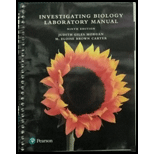
Investigating Biology Laboratory Manual (9th Edition)
9th Edition
ISBN: 9780134473468
Author: Lisa A. Urry, Michael L. Cain, Steven A. Wasserman, Peter V. Minorsky, Jane B. Reece, Judith Giles Morgan, M. Eloise Brown Carter
Publisher: PEARSON
expand_more
expand_more
format_list_bulleted
Concept explainers
Textbook Question
Chapter 16, Problem 1TYU
In his work with pneumonia-causing bacteria and mice, Griffith found that
(A) the protein coat from pathogenic cells was able to transform nonpathogenic cells.
(B) heat-killed pathogenic cells caused pneumonia.
(C) some substance from pathogenic cells was transferred to nonpathogenic cells, making them pathogenic.
(D) the Polysaccharide coat of bacteria caused pneumonia.
Expert Solution & Answer
Want to see the full answer?
Check out a sample textbook solution
Students have asked these similar questions
Explain in a small summary how:
What genetic information can be obtained from a Punnet square? What genetic information cannot be determined from a Punnet square?
Why might a Punnet Square be beneficial to understanding genetics/inheritance?
In a small summary write down:
Not part of a graded assignment, from a past midterm
Chapter 16 Solutions
Investigating Biology Laboratory Manual (9th Edition)
Ch. 16.1 - Given a polynucleotide sequence such as GAATTC,...Ch. 16.1 - VISUAL SKILLS Griffith was trying to develop a...Ch. 16.2 - What role does complementary base pairing play in...Ch. 16.2 - Identify two major functions of DNA pol III in DNA...Ch. 16.2 - Prob. 3CCCh. 16.2 - Prob. 4CCCh. 16.3 - Describe the structure of a nucleosome, the basic...Ch. 16.3 - What two properties, one structural and one...Ch. 16.3 - MAKE CONNECTIONS Interphase chromosomes appear to...Ch. 16 - What does it mean wheti we say that the two DNA...
Ch. 16 - DRAW IT Redraw the Punnett Square on The right...Ch. 16 - Describe the levels of chromatin packing you'd...Ch. 16 - In his work with pneumonia-causing bacteria and...Ch. 16 - What is the basis for tlie difference in how the...Ch. 16 - In analyzing the number of different bases in a...Ch. 16 - The elongation of the leading Strand during DNA...Ch. 16 - In a nucleosome, the DNA is wrapped around (A)...Ch. 16 - E. coli cells grown on, 15N medium are transferred...Ch. 16 - A biochemist isolates, purifies, and combines in a...Ch. 16 - The spontaneous loss of amino groups from adenine...Ch. 16 - MAKE CONNECTIONS Although the proteins that cause...Ch. 16 - EVOLUTION CONNECTION Some bacteria may be able to...Ch. 16 - SCIENTIFIC INQUIRY DRAW IT Model building can be...Ch. 16 - Prob. 12TYUCh. 16 - Prob. 13TYU
Additional Science Textbook Solutions
Find more solutions based on key concepts
Gregor Mendel never saw a gene, yet he concluded that some inherited factors were responsible for the patterns ...
Campbell Essential Biology (7th Edition)
Label each statement about the polynucleotide ATGGCG as true or false. The polynucleotide has six nucleotides. ...
General, Organic, and Biological Chemistry - 4th edition
2. Which of the following is the best example of the use of a referent? _
a. A red bicycle
b. Big as a dump tru...
Physical Science
How does the removal of hydrogen atoms from nutrient molecules result in a loss of energy from the nutrient mol...
SEELEY'S ANATOMY+PHYSIOLOGY
Single penny tossed 20 times and counting heads and tails: Probability (prediction): _______/20 heads ________/...
Laboratory Manual For Human Anatomy & Physiology
Knowledge Booster
Learn more about
Need a deep-dive on the concept behind this application? Look no further. Learn more about this topic, biology and related others by exploring similar questions and additional content below.Similar questions
- Noggin mutation: The mouse, one of the phenotypic consequences of Noggin mutationis mispatterning of the spinal cord, in the posterior region of the mouse embryo, suchthat in the hindlimb region the more ventral fates are lost, and the dorsal Pax3 domain isexpanded. (this experiment is not in the lectures).a. Hypothesis for why: What would be your hypothesis for why the ventral fatesare lost and dorsal fates expanded? Include in your answer the words notochord,BMP, SHH and either (or both of) surface ectoderm or lateral plate mesodermarrow_forwardNot part of a graded assignment, from a past midtermarrow_forwardNot part of a graded assignment, from a past midtermarrow_forward
- please helparrow_forwardWhat does the heavy dark line along collecting duct tell us about water reabsorption in this individual at this time? What does the heavy dark line along collecting duct tell us about ADH secretion in this individual at this time?arrow_forwardBiology grade 10 study guidearrow_forward
arrow_back_ios
SEE MORE QUESTIONS
arrow_forward_ios
Recommended textbooks for you
 Biology: The Dynamic Science (MindTap Course List)BiologyISBN:9781305389892Author:Peter J. Russell, Paul E. Hertz, Beverly McMillanPublisher:Cengage Learning
Biology: The Dynamic Science (MindTap Course List)BiologyISBN:9781305389892Author:Peter J. Russell, Paul E. Hertz, Beverly McMillanPublisher:Cengage Learning Principles Of Radiographic Imaging: An Art And A ...Health & NutritionISBN:9781337711067Author:Richard R. Carlton, Arlene M. Adler, Vesna BalacPublisher:Cengage Learning
Principles Of Radiographic Imaging: An Art And A ...Health & NutritionISBN:9781337711067Author:Richard R. Carlton, Arlene M. Adler, Vesna BalacPublisher:Cengage Learning Biology 2eBiologyISBN:9781947172517Author:Matthew Douglas, Jung Choi, Mary Ann ClarkPublisher:OpenStax
Biology 2eBiologyISBN:9781947172517Author:Matthew Douglas, Jung Choi, Mary Ann ClarkPublisher:OpenStax Human Heredity: Principles and Issues (MindTap Co...BiologyISBN:9781305251052Author:Michael CummingsPublisher:Cengage Learning
Human Heredity: Principles and Issues (MindTap Co...BiologyISBN:9781305251052Author:Michael CummingsPublisher:Cengage Learning

Biology: The Dynamic Science (MindTap Course List)
Biology
ISBN:9781305389892
Author:Peter J. Russell, Paul E. Hertz, Beverly McMillan
Publisher:Cengage Learning

Principles Of Radiographic Imaging: An Art And A ...
Health & Nutrition
ISBN:9781337711067
Author:Richard R. Carlton, Arlene M. Adler, Vesna Balac
Publisher:Cengage Learning


Biology 2e
Biology
ISBN:9781947172517
Author:Matthew Douglas, Jung Choi, Mary Ann Clark
Publisher:OpenStax

Human Heredity: Principles and Issues (MindTap Co...
Biology
ISBN:9781305251052
Author:Michael Cummings
Publisher:Cengage Learning

Mitochondrial mutations; Author: Useful Genetics;https://www.youtube.com/watch?v=GvgXe-3RJeU;License: CC-BY